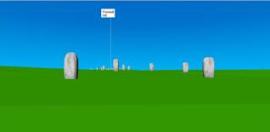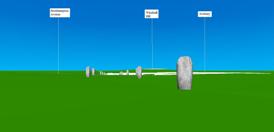

Figure 11: View of Windmill Hill from West Kennet Avenue.
Figure 12: First view of Avebury from West Kennet Avenue.
As one leaves the area of the lithic scatter and climbs the short rise before Avebury, Windmill Hill comes into view (Fig. 11). There is another kink in the avenue here and it gives the impression of turning to head towards Windmill Hill. Again, attention is drawn towards a place of the ancestors, which sits on the horizon, dominating and looking down on those following the avenue However, on cresting the rise the avenue turns right again and its entry to Avebury henge can be seen (Fig. 12).


Figure 11: View of Windmill Hill from West Kennet Avenue.
Figure 12: First view of Avebury from West Kennet Avenue.
Here one is so close to Avebury that it is difficult to take in the whole of the monument without panning one's gaze from side to side. This is in stark contrast to previous views of Falkner's Circle (above), where the whole monument can be easily taken in, thus emphasising the immense size of Avebury. Furthermore, everything taking place in Falkner's Circle is visible, but at Avebury one's view is blocked by the banks and the stones of the entrance way, allowing only brief glimpses of the internal structure. Another feature of the location of Avebury is that it is built on ground slightly higher than that immediately either side of it; this effect is not immediately noticeable as attention is taken by the monument itself, but it subliminally emphasises the structure and is shown well in Figure 13.
The impact of the view is further enhanced by the Beckhampton Avenue (Fig. 12). From this viewpoint it appears to run from the western entrance of Avebury, off into the distance along the near horizon and disappears behind the hillock south of Longstones Field. The kink in the West Kennet Avenue at this point gives the impression that it bypasses Avebury and actually continues straight into the Beckhampton Avenue, just as it had run near to but bypassed Falkner's Circle, further adding to one's state of confusion.
The practice of displaying other monuments, then guiding the viewer past them is demonstrated once again. Windmill Hill, early Neolithic – symbol of the ancestors, can be seen in the distance above Avebury, the centre point of the land of the ancestors. This creates an interesting parallel with the view of Silbury Hill, possible later Neolithic – symbol of the living, on entering the palisade enclosures, a place of the living. Just as at the palisade enclosures, one is guided towards the overlooking monument but blocked from approaching it. Indeed, there is much in common between the approach view of the palisade enclosures and that of Avebury henge. Both have a high monumental site above the entrances (Silbury Hill and Windmill Hill), both have enclosure barriers around 5m tall around them, and both have a radial running off to the left of the view (the palisade enclosure radial and the Beckhampton Avenue).
The avenue then turns again to the east and one is led to the south entrance of Avebury. On approaching the entrance the interior is difficult to understand owing to the narrowness of the entrance, the size of the entrance stones and the seemingly random distribution of stones within. On crossing the entrance in the banks, the whole of the interior can suddenly be taken in. This abrupt transition may mark the final stage in the passage to the world of the dead and one now stands within the sacred place of the ancestors, dwarfed by the nearby stones that are much larger than those of the avenue. However, there is still mystery: sections of the interior, the inner circles and cove, are still bounded and inaccessible giving the impression that only specific individuals might have the closest of links with the ancestors or the ceremony that occurs in these areas (Thomas 1999, 214). At this point one is shepherded to the left by the inner circles and to the large open area between the west and south entrances, an area where mass gathering and ceremony could take place, much as was possible in the open areas of the palisade enclosures.
© Internet Archaeology/Author(s)
URL: http://intarch.ac.uk/journal/issue27/3/3.5.html
Last updated: Tues Oct 27 2009